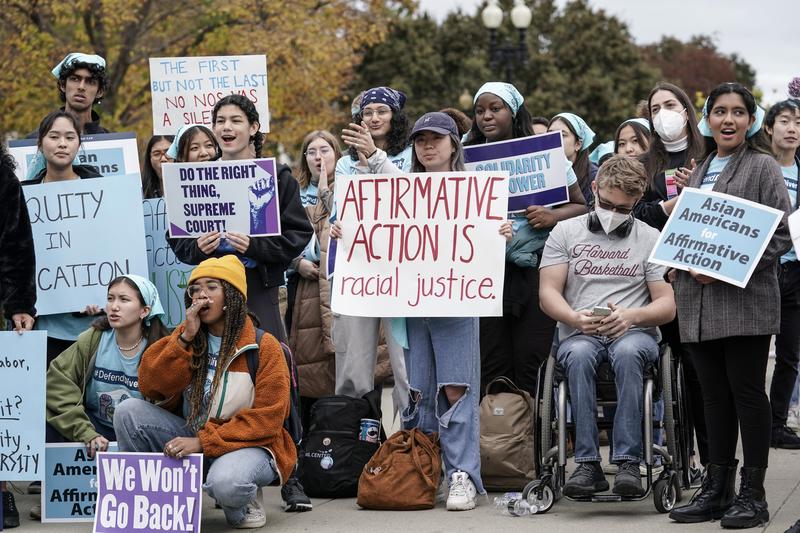What Does “Color-Blind” Really Mean?

[music]
Billie Estrine: Do you think that the goals of affirmative action are feasible without affirmative action?
Speaker 1: No, I went to college as a result of affirmative action, and I can't imagine right now how that's going to work seeing how the society is structured.
Speaker 2: Claires Thomas would not be where he, was, is today if it was not for affirmative action. There's no color-blind in America.
Speaker 1: Why now? Why did they take up that case?
Speaker 2: I think sometimes when you are popular and you are hanging with rich people, you don't recognize that racism exists.
Speaker 3: Yes, I think there's going to be a significant rise in white students and a decline in the number of Black, Hispanic and other community students, which is terrible. I think students will always find a university to go to, but they'll probably come down a tier, which will affect job prospects which will have repercussions over the years.
[music]
Kai Wright: It's Notes from America. I'm Kai Wright. Welcome to the show. We are going to have a conversation this week about the supreme court's ruling ending race-based affirmative action about the ideas articulated in the justice's opinions because for me, the logic behind the ruling is as consequential as the fact of it. Ideas matter and not just as a legal concern. How we define any problem informs how we imagine solutions to it. The ideas in the court's majority and concurring opinions on affirmative action have a long and consequential history. Given the power of this court, maybe they have quite a future too.
To wrap our heads around them, I'm joined by historian Ibram X. Kendi. He's the director of Boston University Center for Anti-racist Research and author of a growing list of bestselling books, including How to Be An Anti-Racist and his epic national book award-winning work Stamped from the Beginning: The Definitive History of Racist Ideas. By the way, a graphic novel adaptation of Stamped has just come out. Ibram, you remain a very busy man. Thanks for coming back on the show.
Ibram X. Kendi: Of course. Thank you for having me.
Kai Wright: Let's talk about the ideas in these opinions. You have written about them extensively. Chief Justice John Roberts wrote the majority of opinion on affirmative action and he's been an opponent for decades. More than that, he's been making a version of the argument he offered in this decision for decades, which is in some, any effort to consider race in making public policy is itself an act of racial discrimination.
In Stamped, in your writing since the ruling in the Atlantic, you've traced the long and winding history of versions of this idea. I want to start with the recent history because in the book, you quote Newt Gingrich saying something in 1997 that sounds exactly like the supreme court in 2023. He said, "Racism will not disappear by focusing on race." Take us back to the mid to late '90s. Why did you point to there as the modern evolution of what you call color-blind racism? How did this thing emerge in today's politics?
Ibram X. Kendi: I believe it was in 1997 when President Clinton at the time decided to lead what he called a national conversation on race and really on racism. Republicans, by and large, challenged that decision by stating that race was no longer a factor, that racism didn't exist, that the nation was color-blind. The term color-blind in reaction to President Clinton's national conversational race-- He put together this committee, which I believe was chaired by the eminent historian, John Hope Franklin. That was the reaction, that we don't need to discuss race let alone eliminate race because the nation is color-blind.
Kai Wright: I think about, you know, this word color-blind. I grew up in the '80s and early '90s and I just remember how people used to say proudly, "I'm color-blind. I'm color-blind. I do not see race." That was proof of an evolved posture on race relations. I always felt some kind of way when I heard it as a young man, even though I didn't really have the words or the language for why it was bothering me. Is this related to that? Do you remember how that used to be the thing that people would say, just individuals? Is this related to what we're talking about here in terms of the color-blind racism that you're describing?
Ibram X. Kendi: It is. I think you had many people who were fed this mistaken belief that the problem isn't racism, isn't racial disparities, isn't racial inequities, that we can empirically document, that the problem is talking about race, is merely identifying by race. If we somehow stop identifying by race, if we stop talking about race, then apparently race will go away. That's like saying if we stop talking about cancer, as a cancer survivor, that suddenly this epidemic of cancer will go away. It was a folly then. It remains a folly.
Kai Wright: But the idea as it emerged as a political thing moving from-- I'm interested in this dichotomy between the common sense thing that I can imagine individuals who are not students of racist ideas say, "Oh yes, great, I shouldn't be thinking about race." That's a very straightforward and common sense-sounding thing, and then how that becomes a political tool for reversing public policy. Go ahead.
Ibram X. Kendi: Well, it became a political tool largely because by the 1960s and especially the 1970s, a growing number of people who recognized widespread racial disparities also recognized that we could not eliminate those racial disparities by ignoring them. We actually needed to take affirmative action in order to close those racial gaps. Those who I should say were trying to conserve those disparities, said those who are trying to reduce them are the new problem.
It was nonsensical. Many of the people who claim color-blindness or who advocate for race neutrality have no plan for reducing racial disparities and typically state Black, brown, and Indigenous people are underrepresented at the most selective colleges because there's something wrong and inferior about them. The very people who say race is not an issue hold racist ideas.
Kai Wright: In those mid to late '90s when Bill Clinton was holding his conversation on race and Newt Gingrich began ranting for color-blindness. One of your arguments that you make in the book is that we were at a unique moment of surge in anti-racism and anti-racist organizing and consensus around anti-racist ideas. Can you just make that case? Thus this was something of a backlash. I don't know if people remember that moment. What are you talking about there?
Ibram X. Kendi: Yes. We're talking about, I should say the late 1980s and the early 1990s, that was the rise of conscious hip hop. That was the rise of Black studies and colleges and universities. That was the rise of critical race theory and law schools, that was the rise of all sorts of anti-racist Black and indigenous and native organizations who were clamoring for self-determination and power. Of course, there was a tremendous backlash that stated, "No, the problem isn't racism. The problem are these people who are organizing against racism." That sounds very familiar to this day.
Kai Wright: Yes. The backlash part of it certainly sounds very familiar to it today. Walking backwards through this history, we're in the '80s and '90s, this idea of color-blindness starts becoming a political tool. Walking back through this history, you write in Stamped from the beginning about the Supreme Court's 1978 ruling that upheld race-based affirmative action, but with this important change in the logic, it was now justified because it created diverse campuses, which was seen as a benefit for all students. That's very different from something that sought to counter the racist practices that had kept particularly Black students out of many universities.
I think a lot of people are probably familiar with that case now. It's come up a lot in the debate over the latest ruling, but I don't hear a lot about the dissenting opinions from the liberal justices in that case. In your book, you point to Harry Blackmun who wrote, I want to quote this. He wrote in his dissenting opinion, "In order to get beyond racism, we must first take account of race. There is no other way. In order to treat some persons equally, we must treat them differently." I was revisiting that. After this ruling, I was going back through your book and I was revisiting that and I thought, "It is impossible to imagine a public official saying something like that today." Do you agree with me? It just felt like a time capsule from another planet.
Ibram X. Kendi: Indeed, and I think you have some elected officials who beat around the bush but Justice Blackmun said it very directly. I agree, it'd be hard-pressed for many elected officials, even those who are defending affirmative action, to say that today.
Kai Wright: Is it still an anti-racist idea in 2023?
Ibram X. Kendi: Without question. We, of course, can talk about race and racism, but any social or political problem, there's no way in which we can identify it and solve it by ignoring it, by not attacking it and addressing it head-on.
Kai Wright: I asked this question also because it does feel like affirmative action like this ruling is the end of an era, but it's also the question of which era. I mean, the era of diversity, I guess, is ending and maybe the era of equity ended with Justice Blackmun's dissent. Am I overstating that case? We're going to talk about this later, but I'm curious. What do you think?
Ibram X. Kendi: Well, let me just say what I hope. I think what I hope, and I've actually already started to see signs of this, what I hope is this is the end of a time in which those of us who are serious about racial justice are agreeing with the logic that there's race neutrality. I think since this decision, you've had more and more people who've spoken out against, for instance, legacy admissions, and recognized the ways in which legacies provide racial preferences to white students. They've spoken out against benefits to relatives of donors. People hopefully are beginning to recognize that affirmative action was not the only admissions factor that was considering race.
Kai Wright: We got to take a break. I'm talking with historian and author, Ibram X. Kendi, about the ideas raised in the supreme court's ruling that ended race-based affirmative action and college admissions. More with Ibram Kendi after a break, stay with us.
[music]
[advertisement]
Kai Wright: Welcome back, it's Notes from America, I'm Kai Wright, and I'm talking with Ibram X. Kendi, Director of Boston University's Centre for Anti-racist Research and author of Stamped from the Beginning: The Definitive History of Racist Ideas, for which there is now a graphic novel adaptation to go along with children's book version and a young adult version.
Ibram, I do think the way you framed this whole stamped project is really notable that it's a history of ideas behind racism. I don't think I've asked you before why you felt the world needed an exhaustive chronicle of racist ideas rather than just the history of what happened.
Ibram X. Kendi: Well, let me just say there's a number of different reasons, I'll just give two. One, because I noticed through the research that there were many people who held both racist and anti-racist ideas, oftentimes said either or both in the same speech, in the same paragraph of the same speech. It would have been hard to write a history of "racist or anti-racist". I also thought it was important to really track who produced these ideas, and why, and what type of impact did they have on society and what type of impact that society have on these ideas.
Kai Wright: One of the ideas, one of the racist ideas that you most directly commented on following the Supreme Court's ruling on affirmative action was the doctrine of separate but equal, you wrote about this in the Atlantic. This is, of course, the idea that made racial segregation legal in the first place. How do the ideas in the court's affirmative action ruling have their lineage in separate but equal?
Ibram X. Kendi: Well, ironically, Chief Justice John Roberts in his majority opinion in the affirmative action case recently talked about the notion that the schools were separate but equal was an inherent folly because everybody knew schools were not separate but equal. I would argue that the lineage is that everyone should know that there are other admissions factors other than affirmative action that give preferential treatment, but almost all of the other ones give preferential treatment to white and wealthy students. Affirmative action is the only admissions factor that primarily benefits Black, brown, and Indigenous students. Unfortunately, he framed all those other admissions factors as race-neutral, which to me is just as much of a folly as the idea a century ago that the schools, which were obviously unequal, were somehow equal.
Kai Wright: Help people with just a step more of that, because I think people hear things like, "Well, that's just like separate but equal," and think, "Well, that's ancient history. That is forever ago, and that is a dead-and-gone idea. How could you possibly listen to John Roberts saying, 'Hey, just like, let's treat everybody the same,' and think, 'Well, that's just like Jim Crow.' " Just do the math a little more for people.
Ibram X. Kendi: Sure. John Roberts said again and again, that affirmative action was the only race-based admissions factor. Standardized tests which studies consistently show that they don't actually predict who's going to do well in college or even graduate school, but they do predict the wealth or the income of the parents of the test takers. We have a massive racial wealth gap in this country which then allows white and wealthy students to be able to use high-priced test prep courses which then boosts their scores. To imagine that a standardized test is somehow race-neutral denies the racial wealth gap, denies what studies show in terms of what standardized test scores predict, similarly for legacies.
A lot of people have been talking about a study that was conducted at Harvard which found that a large percentage of their white students either were admitted as the result of being the children of alumni, the relatives of donors, athletes, or even the children of employees. Indeed, the study found that about 3/4 of white students, if they didn't have those four admissions boosts, would not have gotten admitted.
All four of those elements give preferential treatment to white students. White students have the ability to get boosted because their parents are more likely to be on the faculty and staff, their parents are more likely to donate, their parents were not shut out of these schools for hundreds of years like Black and Indigenous students, and white students are more likely to be playing high-priced sports that gets them in the colleges. To imagine those factors are race-neutral, again, flies in the face of reality.
Kai Wright: It's in seeing, it's in looking at something plainly with plainly inequitable outcomes, calling it neutral, but then once the word race is said, saying that's racist, and that's the same ideas that supported Jim Crow in the first place.
Ibram X. Kendi: Exactly. Because, remember, a century ago, Mississippi and Alabama, were saying that their schools were separate but equal. Just as people are saying that these other admissions factors are neutral.
Kai Wright: You work in a university setting, obviously. Stepping back from the history and just talking about yourself and your students, what was your reaction to the court's ruling?
Ibram X. Kendi: It was devastating because I know that it's going to be harder for highly qualified, Black, brown, and Indigenous students and even many low-income, Asian, and white students to get into a selective university like Boston University and others like it. I know that many selective universities have directly or indirectly stated that they're going to use more income-based or zip code-based factors.
One of the things we wrote about in that article in The Atlantic, is how even when you use class-based factors, you're still likely to benefit white students because low-income white students are less likely to live in highly impoverished neighborhoods. Their parents are less likely to have to send their kids to lesser-resource schools. They're going to benefit too even by this new effort.
Kai Wright: You went to Florida A&M University for college, FAMU, a historically Black university. There's been some discussion now in the wake of this about why are we focused on these selective white majority institutions so much. Shouldn't we be supporting stuff like explicitly pro-Black spaces like HBCUs instead? You want to wade into that debate at all before I let you go?
Ibram X. Kendi: Well, I think we could do both.
Kai Wright: There you go.
Ibram X. Kendi: We can promote and enhance and defend HBCUs as just as valuable if not more valuable than many historically white colleges universities while also knowing that students who live on the West Coast or the Midwest, or the Northeast who want to stay close to home, they don't have an option to go to an HBCU. We should ensure that the admissions factors are fair and equal for them.
Kai Wright: Ibram X. Kendi is director of Boston University's Center for Anti-racist Research. He's the author of the best-selling book, How to Be an Antiracist, and the national book award-winning Stamped from the Beginning: The Definitive History of Racist Ideas for which there is now a graphic novel adaptation. Ibram, thanks so much for this time.
Ibram X. Kendi: Of course. Thank you for having me.
[music]
Kai Wright: Notes from America is a production of WNYC Studios. Follow us wherever you get your podcasts and on Instagram @noteswithkai. Themed music by Jared Paul. Matthew Marando is our live engineer. Our team also includes Billie Estrine, Karen Frillmann, Regina de Heer, Rahima Nasa, Kousha Navidar, and Lindsay Foster Thomas. André Robert Lee is our executive producer. I'm Kai Wright. I'll talk to you next week.
[music]
Copyright © 2023 New York Public Radio. All rights reserved. Visit our website terms of use at www.wnyc.org for further information.
New York Public Radio transcripts are created on a rush deadline, often by contractors. This text may not be in its final form and may be updated or revised in the future. Accuracy and availability may vary. The authoritative record of New York Public Radio’s programming is the audio record.





